- Yew Planting Guide
- 1. Selecting the Planting Location
- 2. Preparing the Soil
- 3. Digging the Hole
- 4. Planting the Yew
- 5. Mulching
- 6. Watering
- 7. Pruning
- 8. Fertilizing
- 9. Pests and Diseases
- 10. Transplanting Yew
- Choosing the Right Location
- Light Requirements
- Soil Type
- Climate
- Spacing
- Other Considerations
- Soil preparation
- Yew Planting Tips
- Watering and fertilizing
- Watering
- Fertilizing
- Pruning and trimming
- When to prune
- Tools for pruning
- Pruning techniques
- Trimming hedges
- Safety precautions
- Yew Propagation Methods
- 1. Seed Germination
- 2. Stem Cutting
- 3. Air Layering
- Transplanting yews
- When to transplant yews
- Preparing the yew for transplanting
- Choosing a new location
- Transplanting the yew
- Caring for transplanted yews
- Conclusion
- Common yew problems and solutions
- Disease and pest infestations
- Environmental issues
- Improper pruning
- Transplant shock
- Conclusion
- Questions and Answers:
- What is yew?
- How do I plant yew?
- What care does yew require?
- How do I propagate yew?
- When is the best time to transplant yew?
- How deep should I dig when transplanting yew?
- Can yew be grown in containers?
- Videos: pruning Yew shrubs, how to cut back Taxus, different types of yews explained
Yew trees, scientifically known as Taxus, are evergreen conifers that are native to Europe, North Africa, and Asia. These trees are highly popular in landscaping due to their aesthetic appeal and low maintenance requirements. In this guide, we will explore everything you need to know about planting, caring for, propagating, and transplanting yew trees.
When it comes to planting yew trees, it is important to choose a location that receives partial to full sun. Yews prefer well-draining soil and can tolerate a wide range of soil types, including clay and sandy soils. Before planting, it is recommended to amend the soil with organic matter to improve drainage and fertility.
Caring for yew trees involves regular watering, especially during hot and dry periods. While established yew trees are generally drought-tolerant, consistent watering is essential during the first year after planting to help the tree establish its root system. It is also important to mulch around the base of the tree to retain moisture and suppress weed growth.
Propagation of yew trees can be done through various methods, including stem cuttings, seed propagation, and grafting. Stem cuttings are the most common and successful method, involving the collection of young shoots in the spring or early summer and rooting them in a moist growing medium. Seeds collected from yew trees can also be sown in pots or trays, but they may take several years to germinate and establish.
Transplanting yew trees should be done with caution, as these trees have sensitive root systems. It is best to transplant yews during their dormant season, which is typically in late fall or early spring. Care should be taken to minimize root disturbance and provide adequate water and mulch after transplanting to support the tree’s recovery.
Overall, yew trees are a fantastic addition to any landscape. With proper planting, care, propagation, and transplanting techniques, you can enjoy the beauty of these evergreen conifers for years to come. Remember to consult local gardening experts for specific advice based on your region’s climate and conditions.
Yew Planting Guide
1. Selecting the Planting Location
When planting yew, it is important to choose a location that meets the preferences of this evergreen shrub. Yews thrive in part shade to full shade conditions and prefer well-draining soil. They can tolerate a range of soil types, but it is best to avoid waterlogged or compacted soil. Choose a spot that is protected from harsh winds.
2. Preparing the Soil
Before planting yew, prepare the soil by removing any weeds or grass from the planting area. Loosen the soil with a garden fork or tiller to a depth of about 12 inches. Incorporate organic matter, such as compost or aged manure, into the soil to improve drainage and fertility.
3. Digging the Hole
The planting hole should be wide and deep enough to accommodate the roots of the yew plant. The hole should be about twice as wide and slightly deeper than the plant’s root ball. This will allow room for the roots to spread out and establish properly.
4. Planting the Yew
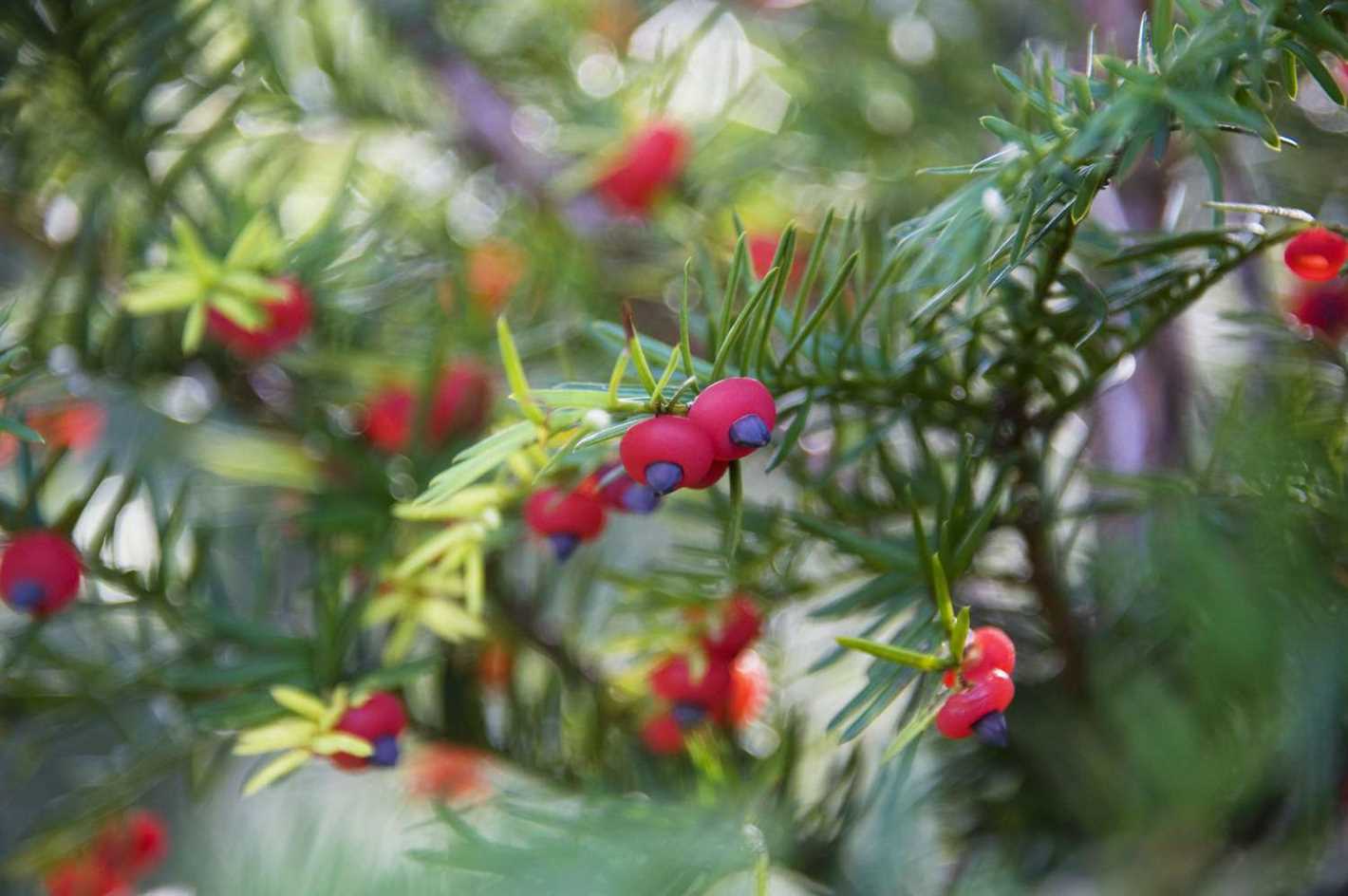
Carefully remove the yew plant from its container and gently loosen any tightly-bound roots. Place the plant in the center of the hole, making sure it is at the same level as it was in the container. Backfill the hole with soil, firming it gently around the root ball to eliminate air pockets. Water the plant thoroughly.
5. Mulching
Apply a layer of mulch around the base of the yew plant to help conserve moisture, suppress weed growth, and regulate soil temperature. Use organic mulch, such as wood chips or bark, and spread it to a depth of 2-3 inches. Keep the mulch several inches away from the trunk of the plant to prevent rotting.
6. Watering
Keep the soil around the yew plant consistently moist, but not waterlogged. Water deeply once a week, providing enough water to saturate the root zone. During hot and dry periods, additional watering may be necessary.
7. Pruning
Pruning is an important part of yew care. Trim the yew plant in early spring before new growth begins. Remove any dead or damaged branches and shape the plant as desired. Yews can tolerate heavy pruning, so they can be shaped into hedges or topiaries.
8. Fertilizing
Apply a balanced slow-release fertilizer in early spring to provide the yew plant with essential nutrients. Follow the manufacturer’s instructions for the appropriate amount and frequency of application.
9. Pests and Diseases
Yews are generally resistant to pests and diseases, but they can occasionally be affected by scale insects, spider mites, or fungal diseases. Monitor the plant regularly and take appropriate action if any issues arise, such as pruning affected branches or applying horticultural oils.
10. Transplanting Yew
If you need to transplant a yew, it is best to do so in early spring or late fall when the plant is dormant. Follow the same planting and care instructions as for initial planting, ensuring the new location meets the yew’s preferences.
| Pros | Cons |
|---|---|
| Evergreen foliage adds year-round interest | Can be toxic if ingested by humans or pets |
| Tolerates shade and a range of soil types | Slow growth rate |
| Drought-tolerant once established | Can be susceptible to deer browsing |
| Can be pruned into various shapes | May require regular pruning to maintain desired shape |
Choosing the Right Location
When it comes to choosing the right location for your yew plants, there are a few important factors to consider. Yews are hardy plants that can tolerate a wide range of growing conditions, but they do have preferences.
Light Requirements
Yew plants prefer partial to full shade, although they can tolerate some direct sunlight. If you plant them in full sun, they may become stressed and their growth may be stunted. On the other hand, if you plant them in deep shade, they may not receive enough light to thrive.
Soil Type
Yews prefer moist, well-draining soil. They can tolerate a variety of soil types, including sandy, loamy, and clay soils. However, they do not tolerate waterlogged or poorly drained soil. If you have heavy clay soil, consider improving drainage by adding organic matter.
Climate
Yews are generally hardy in USDA plant hardiness zones 4 to 7. They can tolerate cold winters and hot summers, but extreme temperatures can stress them. If you live in an area with harsh winters or scorching summers, you may need to provide some protection for your yew plants.
Spacing
Yews are typically planted as hedges or foundation plants. When choosing a location, make sure you have enough space for the mature size of the plants. Yews can grow up to 6 to 8 feet tall and spread 4 to 6 feet wide. Provide enough space between plants for proper air circulation and growth.
Other Considerations
It’s also important to consider other factors such as proximity to buildings or other structures, as well as any potential obstructions or competition from other plants. Yews have shallow roots, so avoid planting them near structures with deep foundations.
| Light | Partial to full shade |
| Soil | Moist, well-draining |
| Climate | Hardy in zones 4 to 7 |
| Spacing | 6 to 8 feet tall, 4 to 6 feet wide |
By considering these factors, you can choose the best location for your yew plants and ensure they thrive in your garden.
Soil preparation
- Choose a well-draining soil for planting yew trees. Yews prefer slightly acidic to neutral soil pH levels ranging from 6.0 to 7.5.
- Before planting, it is advisable to test the soil to determine its pH level. This can be done using a soil testing kit or by sending a sample to a local agricultural extension office.
- If the soil pH is too high, it can be lowered by adding elemental sulfur or other acidifying agents. If the soil pH is too low, it can be raised by adding lime or other alkalizing agents.
- Yews also prefer a soil that is rich in organic matter. Incorporate compost, well-rotted manure, or other organic materials into the soil before planting to improve fertility and drainage.
- Clear the planting area of any weeds or grasses to reduce competition with the yew tree for nutrients and water.
- It is recommended to loosen the soil in the planting area by tilling or digging. This will help to improve root penetration and establish a stronger root system.
- Consider adding a layer of mulch around the base of the yew tree after planting. This helps to conserve moisture, suppress weed growth, and regulate soil temperature.
- Water the soil thoroughly after planting to settle it around the roots and provide initial hydration to the yew tree. Afterward, water the tree regularly, especially during dry spells and hot weather.
Yew Planting Tips
Planting yew trees requires careful consideration and attention to detail. Here are some tips to help you successfully plant yew trees:
- Choose the right location: Yew trees prefer well-drained soil and partial shade. Select a location that provides a balance of sunlight and shade throughout the day.
- Prepare the soil: Before planting, make sure to prepare the soil by removing any weeds, rocks, or debris. Yew trees thrive in soil that is rich in organic matter, so consider adding compost or well-rotted manure to improve the soil’s fertility.
- Plant at the right depth: When planting yew trees, make sure to dig a hole that is slightly larger and deeper than the root ball. Place the tree in the hole, making sure that the top of the root ball is level with or slightly above the soil surface.
- Water regularly: Yew trees need consistent moisture, especially during the first year after planting. Water the tree deeply at least once a week, especially during dry periods. Be careful not to overwater, as excessive moisture can lead to root rot.
- Mulch: Apply a layer of organic mulch around the base of the tree, leaving a gap around the trunk to prevent moisture buildup. Mulch helps retain moisture, suppresses weed growth, and provides insulation to the roots during extreme temperatures.
- Prune with caution: Yew trees have a dense growth habit and are known for their ability to regenerate from old wood. Prune yew trees only when necessary and avoid heavy pruning, as this can damage the tree’s shape and reduce its vigor.
- Protect from extreme temperatures: Yew trees are generally hardy, but they can be susceptible to winter damage in extremely cold climates. Consider wrapping the tree with burlap or applying a protective spray to prevent winter burn.
- Monitor for pests and diseases: Yew trees are generally resistant to many pests and diseases. However, keep an eye out for common issues like scale insects, powdery mildew, and root rot. If any problems arise, take appropriate measures to address them promptly.
- Transplant carefully: If you need to transplant a yew tree, do so during the dormant season. Take care to dig up as much of the root ball as possible and replant it in its new location immediately. Water the tree thoroughly after transplantation to help it establish new roots.
By following these planting tips, you can ensure the successful growth and health of your yew trees.
Watering and fertilizing
Proper watering and fertilizing are essential for the health and growth of yew plants. Here are some important tips to keep in mind:
Watering
Yew plants are fairly drought-tolerant once established, but they still require regular watering, especially during dry periods. Follow these watering guidelines:
- Water yew plants deeply and thoroughly, ensuring the soil is evenly moist.
- Aim to water the plants at least once a week, providing enough water to penetrate the root zone.
- When watering, avoid getting the foliage wet, as this can lead to diseases.
- Consider using a drip irrigation system or a soaker hose to deliver water directly to the roots.
Fertilizing
Yew plants generally do not require heavy fertilization, but a light application of fertilizer can help promote growth and greener foliage. Here are some fertilizing tips:
- Apply a balanced slow-release granular fertilizer to the soil in early spring or late fall.
- Follow the package instructions for the proper amount of fertilizer to use.
- Avoid over-fertilizing, as this can lead to excessive growth and weaker plants.
- Water the plants after applying fertilizer to help it penetrate the soil.
Regularly monitoring the moisture level and providing appropriate watering and fertilization will ensure the healthy growth and vitality of your yew plants.
Pruning and trimming
Pruning and trimming are important tasks in maintaining the health and appearance of yew plants. Proper pruning can help promote growth, maintain shape, and remove any diseased or damaged branches.
When to prune
The best time to prune yew plants is in late winter or early spring, before new growth starts. This is because yews are slow-growing and tend to develop new growth later in the spring. Pruning during this dormant period helps minimize stress on the plant.
Tools for pruning
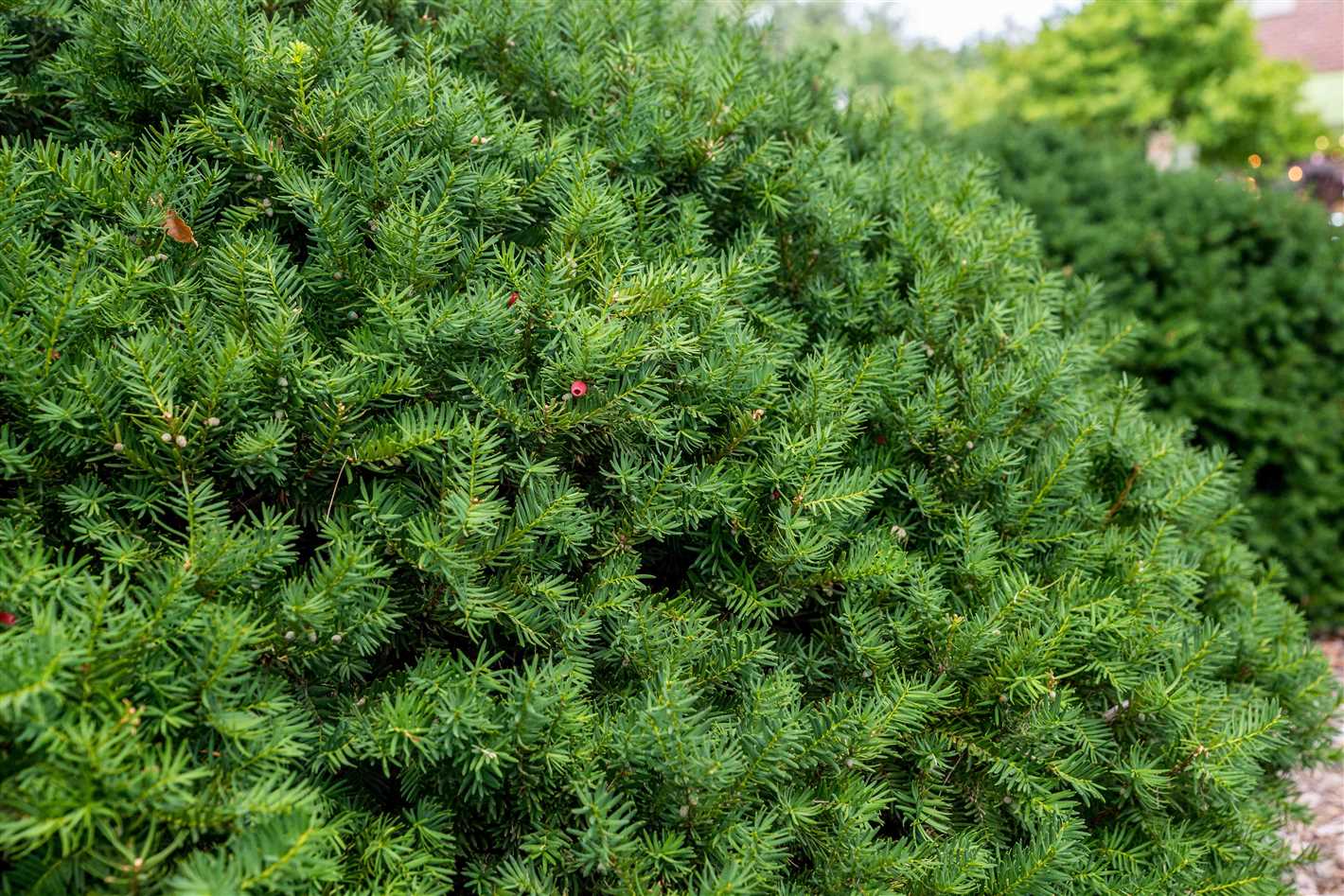
When pruning, it is important to use sharp and clean pruning tools. This ensures clean cuts and reduces the risk of spreading diseases. Pruning shears or loppers are suitable for most pruning tasks on yew plants. For larger branches, a pruning saw may be necessary.
Pruning techniques
There are several pruning techniques that can be used for yew plants:
- Thinning: This involves selectively removing branches to open up the interior of the plant, allowing for better air circulation and light penetration.
- Heading back: This technique is used to control the size and shape of the plant by cutting back the tips of branches. It encourages a more compact growth habit.
- Renewal pruning: This is done to rejuvenate an overgrown or neglected yew plant. It involves cutting back the entire plant to a few inches from the ground. This drastic pruning stimulates new growth from the base.
Trimming hedges
Yew hedges are a popular option for creating privacy and defining boundaries. Trimming yew hedges can help maintain a neat and formal appearance. It is best to trim yew hedges in late spring or early summer, after the initial new growth has occurred. Regular trimming is necessary to prevent the hedge from becoming too dense and to encourage fullness.
Safety precautions
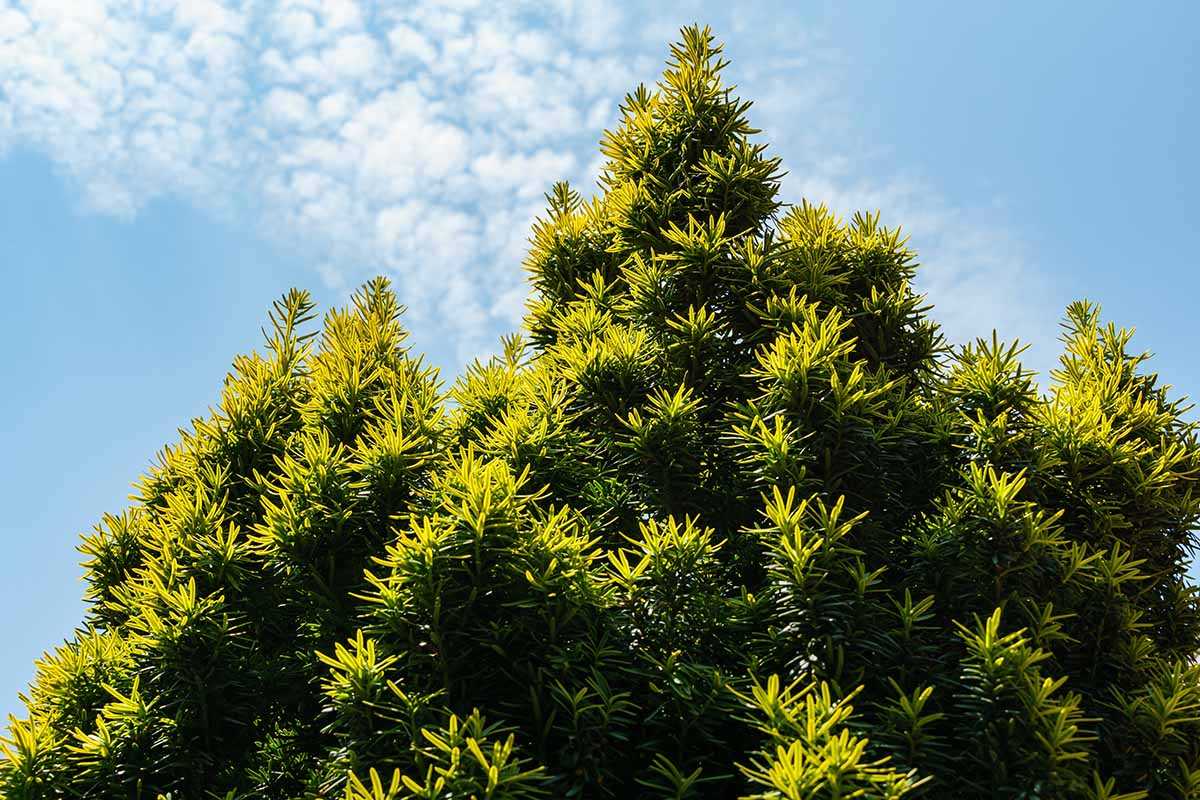
When pruning yew plants, it is important to wear protective gloves and eyewear. The foliage of yews contains toxic compounds, and contact with the sap or leaves can cause skin irritation. Additionally, pruning tools can be sharp and potentially dangerous, so caution should be exercised.
Overall, pruning and trimming yew plants are essential tasks for maintaining their health and appearance. With proper technique and timing, yews can be kept looking their best for years to come.
Yew Propagation Methods
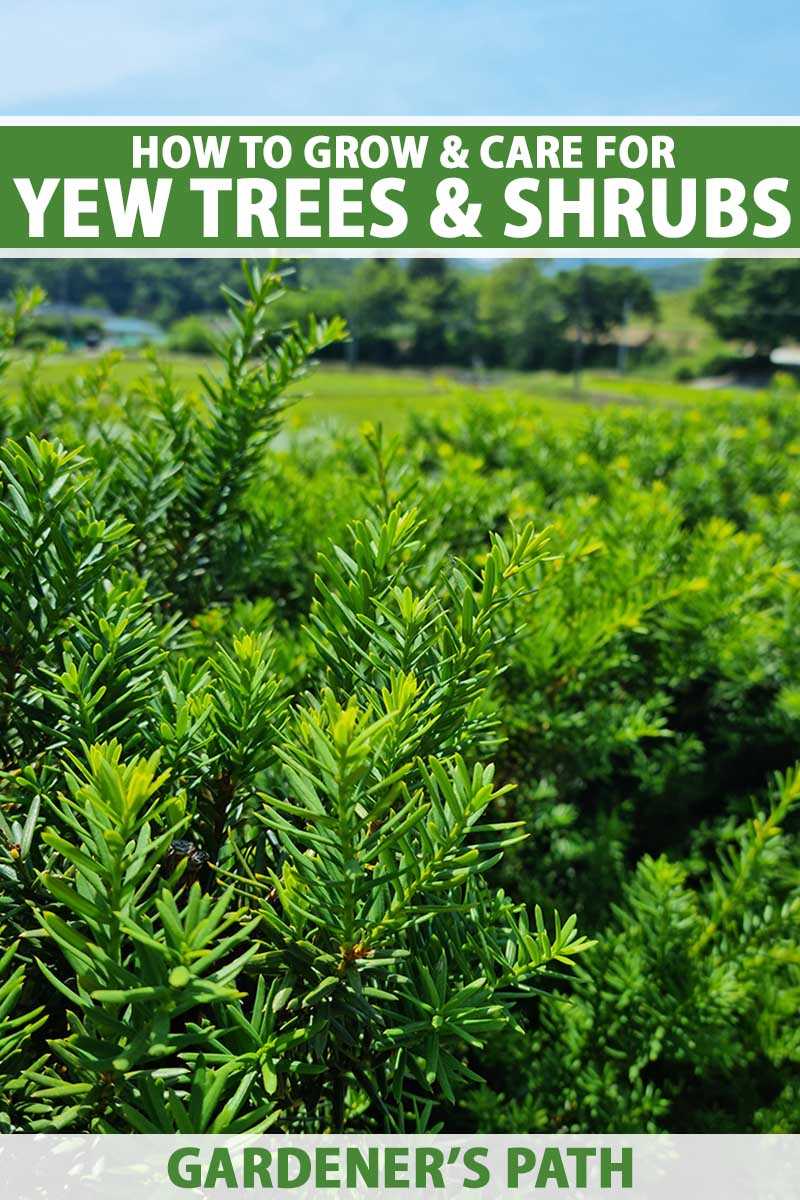
Yew trees can be propagated through several methods, including seed germination, stem cutting, and air layering. Each method has its own advantages and challenges, so it’s important to choose the one that best suits your resources and goals.
1. Seed Germination
- Collect fresh yew seeds in late summer or early autumn, as they have a short shelf life.
- Remove the fleshy outer covering from the seeds by soaking them in water for a few days.
- Place the seeds in a well-draining potting mix and cover lightly with soil.
- Maintain a consistently moist environment and provide indirect light.
- Germination can take anywhere from a few weeks to a few months.
- Transplant the seedlings into separate containers once they have developed several true leaves.
- It may take several years for seed-grown yews to reach a suitable size for transplanting outdoors.
2. Stem Cutting
- Select healthy, non-flowering stems in late spring or early summer.
- Cut a 4-6 inch (10-15 cm) section of the stem, just below a leaf node.
- Remove the lower leaves and dip the cut end in a rooting hormone.
- Place the cutting in a well-draining potting mix and keep it moist.
- Provide indirect light and maintain a warm temperature of around 70-75°F (21-24°C).
- Roots should start to develop within a few weeks to a few months.
- Transplant the rooted cuttings into separate containers once they have established a healthy root system.
- These new plants can be transplanted outdoors after a year or two of growth.
3. Air Layering
- Select a healthy stem that is flexible and easy to work with.
- Make a small wound on the stem by removing a thin strip of bark.
- Apply rooting hormone to the wounded area.
- Wrap moist sphagnum moss around the wounded area and cover it with plastic wrap or a bag.
- Secure the moss and plastic wrap tightly with a twist tie or string.
- Check the moss regularly and keep it moist, but not soaking wet.
- After several months, roots should form where the wound was made.
- Carefully cut the stem below the rooted area and transplant the new plant into a container or the ground.
With proper care and patience, yews can be successfully propagated through these methods. Experiment with different techniques to determine which one works best for you and enjoy growing your own yew trees!
Transplanting yews
Transplanting yews can be a great way to rejuvenate your garden or to move a yew shrub from one location to another. However, it is important to handle yews with care during the transplanting process to ensure their survival and promote healthy growth in their new environment.
When to transplant yews
The best time to transplant yews is in early spring or late fall when the weather is cool and the yew is in a semi-dormant state. Transplanting during these seasons will reduce stress on the plant and give it time to establish its roots before the arrival of extreme temperatures.
Preparing the yew for transplanting
- Start by watering the yew deeply a few days before transplanting. This will help keep the roots moist and make it easier to lift the plant.
- Using a sharp spade or shovel, dig a generous root ball around the yew. Make sure to dig deep enough to get most of the root system.
- Gently lift the yew, taking care not to damage the roots, and place it onto a tarp or burlap for easy transportation.
Choosing a new location
When selecting a new location for your yew, consider its growing requirements. Yews prefer well-draining soil with a slightly acidic to neutral pH. They can tolerate some shade but thrive in full sun to partial shade.
Transplanting the yew
- Prepare the new planting hole by digging a hole slightly larger than the root ball of the yew.
- Place the yew into the planting hole, making sure that the top of the root ball is level with or slightly above the soil surface.
- Backfill the hole with soil, firming it gently around the roots to remove any air pockets.
- Water the transplanted yew thoroughly to settle the soil and provide moisture to the roots.
Caring for transplanted yews
After transplanting, it is important to water the yew regularly, especially during the first year, to help it establish its root system. Apply a layer of mulch around the base of the plant to retain moisture and suppress weed growth. Avoid using fertilizer immediately after transplanting, as this can cause root burn. Prune any damaged or crossing branches to encourage healthy growth.
Conclusion
Transplanting yews can be a rewarding experience, but it requires careful planning and execution. By following the proper transplanting techniques and providing appropriate care, you can successfully move and establish yews in a new location, adding beauty and structure to your garden.
Common yew problems and solutions
Disease and pest infestations
Yews are generally resistant to most diseases and pests. However, they can occasionally be affected by certain issues:
- Phytophthora root rot: This fungal disease can cause root decay and subsequent death of the yew. To prevent this, make sure the soil is well-drained and avoid over-watering the plant.
- Needle blight: Needle blight is a fungal disease that can cause discoloration and browning of the needles. To prevent it, ensure proper air circulation around the plants and avoid watering from above.
- Scale insects: These small pests can attach themselves to the needles and suck sap from the plant, causing damage. Use horticultural oil or insecticidal soap to control them.
- Aphids: Aphids can also infest yews and cause damage to new growth. Use insecticidal soap or neem oil to control them.
Environmental issues
Yews may also face problems caused by environmental factors:
- Drought stress: Yews are susceptible to drought stress, which can cause wilting and browning of the foliage. Regular watering, especially during dry periods, can help prevent this issue.
- Excessive moisture: On the other hand, yews can be adversely affected by excessive moisture, leading to root rot or other fungal diseases. Ensure proper drainage and avoid over-watering.
Improper pruning
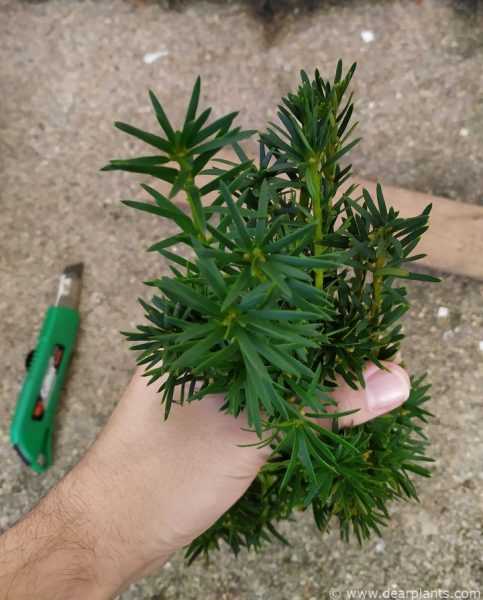
Improper pruning practices can also cause problems for yews:
- Over-pruning: Yews should not be heavily pruned as it can result in weak growth and susceptibility to disease. Avoid removing more than one-third of the plant’s foliage in a single season.
- Improper timing: Pruning yews at the wrong time can disrupt their growth cycle and affect their overall health. The best time to prune yews is in late winter or early spring before new growth begins.
Transplant shock
Transplanting yews can sometimes result in transplant shock:
- Watering: Proper watering is crucial after transplanting to help the roots establish. Ensure the soil remains consistently moist, but not waterlogged.
- Root damage: During transplanting, the roots can be damaged, which can lead to stress and potential failure. Be careful when handling the plant and ensure the roots remain intact.
- Adjustment period: Yews may experience a period of adjustment after transplanting, during which they may appear distressed. With proper care and time, they will generally recover and resume growth.
Conclusion
By being aware of these common yew problems and their solutions, you can better care for your yew plants and ensure their long-term health and beauty.
Questions and Answers:
What is yew?
Yew is an evergreen shrub or tree known for its dense foliage and red berries. It is often grown as an ornamental plant in gardens.
How do I plant yew?
To plant yew, choose a location with well-drained soil and partial shade. Dig a hole that is slightly larger than the root ball, place the yew in the hole, and cover the roots with soil. Water thoroughly after planting.
What care does yew require?
Yew requires regular watering, especially during dry periods. It also benefits from annual pruning to maintain its shape and promote new growth. Applying a layer of mulch around the base of the plant can help retain moisture and regulate soil temperature.
How do I propagate yew?
Yew can be propagated through both seeds and cuttings. To propagate from seeds, collect mature berries and remove the seeds. Plant them in a pot or directly in the ground, and keep the soil moist until germination. To propagate from cuttings, take a 6-8 inch cutting from a healthy yew plant, remove the lower leaves, and plant it in a pot with well-draining soil. Keep the cutting in a warm and humid environment until it develops roots.
When is the best time to transplant yew?
The best time to transplant yew is in early spring or late fall when the plant is dormant. This allows the roots to establish themselves in the new location before the growing season begins.
How deep should I dig when transplanting yew?
When transplanting yew, dig a hole that is two times wider and one-third deeper than the root ball. This extra space gives the roots room to spread out and establish themselves in the new location.
Can yew be grown in containers?
Yes, yew can be grown in containers. Choose a large container with good drainage, and use a well-draining potting mix. Make sure to water the yew regularly and provide it with adequate sunlight. Pruning may be necessary to keep the plant in a manageable size.







